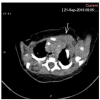Reinforcing the vascular disruption theory of the genesis of Poland's syndrome: a rare association of diaphragmatic eventration in a preterm infant with severe musculoskeletal defects
- PMID: 33509875
- PMCID: PMC7845722
- DOI: 10.1136/bcr-2020-238392
Reinforcing the vascular disruption theory of the genesis of Poland's syndrome: a rare association of diaphragmatic eventration in a preterm infant with severe musculoskeletal defects
Abstract
A preterm female infant was admitted at birth with respiratory distress. On examination, she had an asymmetric right chest wall and ipsilateral small hand. Air entry was reduced over the right chest. A clinical diagnosis of Poland's syndrome was made based on the hypoplasia of the right pectoral muscles, absent nipple, deformed ribs and symbrachydactyly of the ipsilateral hand. Chest X-ray suggested and ultrasound confirmed eventration of the right hemidiaphragm. 'Subclavian artery supply disruption sequence' (SASDS) theory by Bavnick and Weaver remains the most accepted pathogenic mechanism in Poland's syndrome. This case reinforces SASDS theory associated with the genesis of Poland's syndrome that relates to the pathogenicity of vascular disruption of subclavian artery, characteristics of which are unilateral pectoral defects, symbrachydactyly and eventration of the diaphragm. At 2 months, she underwent diaphragm plication. She is under review by our multidisciplinary surgical team for reconstruction of the chest deformity.
Keywords: genetics; musculoskeletal and joint disorders; neonatal intensive care; radiology (diagnostics); respiratory system.
© BMJ Publishing Group Limited 2021. No commercial re-use. See rights and permissions. Published by BMJ.
Conflict of interest statement
Competing interests: None declared.
Figures




Similar articles
-
A narrative review of Poland's syndrome: theories of its genesis, evolution and its diagnosis and treatment.Transl Pediatr. 2021 Apr;10(4):1008-1019. doi: 10.21037/tp-20-320. Transl Pediatr. 2021. PMID: 34012849 Free PMC article. Review.
-
Poland's anomaly.Indian J Med Res. 2014 Mar;139(3):476. Indian J Med Res. 2014. PMID: 24820847 Free PMC article. No abstract available.
-
Eight patients with multiple bilateral thoracic anomalies: a new syndrome or bilateral Poland's syndrome?Ann Thorac Surg. 2014 May;97(5):1758-63. doi: 10.1016/j.athoracsur.2014.01.027. Epub 2014 Mar 12. Ann Thorac Surg. 2014. PMID: 24630765
-
Poland's syndrome complicated with breast cancer: mammographic, ultrasonographic, and computed tomographic findings.Acta Radiol. 2008 May;49(4):387-90. doi: 10.1080/02841850801922904. Acta Radiol. 2008. PMID: 18415780
-
Breast cancer and Poland's syndrome: a case report and literature review.Breast J. 2011 Mar-Apr;17(2):196-200. doi: 10.1111/j.1524-4741.2010.01042.x. Breast J. 2011. PMID: 21410586 Review.
Cited by
-
Management of Axillary Contracture in Poland Syndrome: Differentiating Fibrous Band and Skin for Optimal Release.J Clin Med. 2023 Jul 28;12(15):4957. doi: 10.3390/jcm12154957. J Clin Med. 2023. PMID: 37568359 Free PMC article.
-
Poland Syndrome in a Pregnancy From an Assisted Reproductive Technology (ART) Cycle With In Vitro Maturation (IVM) and Rescue Intracytoplasmic Sperm Injection (ICSI).Cureus. 2024 Mar 26;16(3):e56936. doi: 10.7759/cureus.56936. eCollection 2024 Mar. Cureus. 2024. PMID: 38665724 Free PMC article.
-
A narrative review of Poland's syndrome: theories of its genesis, evolution and its diagnosis and treatment.Transl Pediatr. 2021 Apr;10(4):1008-1019. doi: 10.21037/tp-20-320. Transl Pediatr. 2021. PMID: 34012849 Free PMC article. Review.
-
Is there a genomic link and common pathogenesis (postzygotic mutations in beta-actin) for Poland syndrome and Becker nevus syndrome?Transl Pediatr. 2021 Oct;10(10):2639-2640. doi: 10.21037/tp-21-409. Transl Pediatr. 2021. PMID: 34765488 Free PMC article. No abstract available.
References
-
- Poland A. Deficiency of the pectoral muscles. Guy’s Hosp Rep 1841;6:191–3.
-
- Froriep R. Beobachtungeines Falles von Mangel Der Brustdruse. Notizen Ausdem Gebiete der Natur und Heilkinde 1839;10:9–14.
-
- Clarkson P. Poland's syndactyly. Guys Hosp Rep 1962;111:335–46. - PubMed
-
- Baudinne P, Bovy GL, Wasterlain A. Un Cas de syndrome de Poland. Acta Paediatrica Belgica 1967;21:407–10. - PubMed
Publication types
MeSH terms
Supplementary concepts
Grants and funding
LinkOut - more resources
Full Text Sources
Other Literature Sources
Medical
